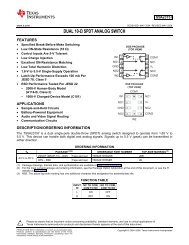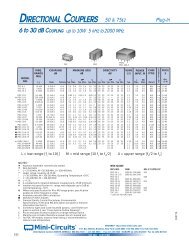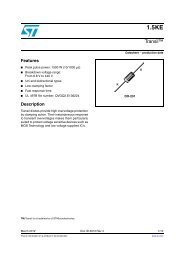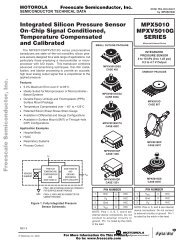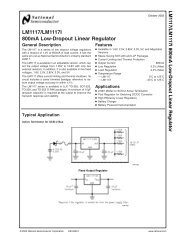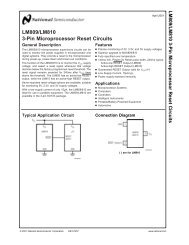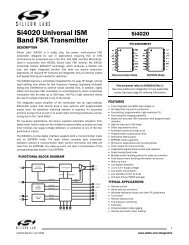LM3445 Triac Dimmable Offline LED Driver
LM3445 Triac Dimmable Offline LED Driver
LM3445 Triac Dimmable Offline LED Driver
You also want an ePaper? Increase the reach of your titles
YUMPU automatically turns print PDFs into web optimized ePapers that Google loves.
Design Guide<br />
DETERMINING DUTY-CYCLE (D)<br />
Duty cycle (D) approximately equals:<br />
With efficiency of the buck converter in mind:<br />
<strong>LM3445</strong><br />
Substitute equations and rearrange:<br />
With efficiency considered:<br />
For simplicity, choose efficiency between 75% and 85%.<br />
CALCULATING OFF-TIME<br />
The “Off-Time” of the <strong>LM3445</strong> is set by the user and remains<br />
fairly constant as long as the voltage of the <strong>LED</strong> stack remains<br />
constant. Calculating the off-time is the first step in determining<br />
the switching frequency of the converter, which is integral<br />
in determining some external component values.<br />
PNP transistor Q3, resistor R4, and the <strong>LED</strong> string voltage<br />
define a charging current into capacitor C11. A constant current<br />
into a capacitor creates a linear charging characteristic.<br />
Resistor R4, capacitor C11 and the current through resistor<br />
R4 (i COLL ), which is approximately equal to V <strong>LED</strong> /R4, are all<br />
fixed. Therefore, dv is fixed and linear, and dt (t OFF ) can now<br />
be calculated.<br />
Off-time, and switching frequency can now be calculated using<br />
the equations above.<br />
SETTING THE SWITCHING FREQUENCY<br />
Selecting the switching frequency for nominal operating conditions<br />
is based on tradeoffs between efficiency (better at low<br />
frequency) and solution size/cost (smaller at high frequency).<br />
The input voltage to the buck converter (V BUCK ) changes with<br />
both line variations and over the course of each half-cycle of<br />
the input line voltage. The voltage across the <strong>LED</strong> string will,<br />
however, remain constant, and therefore the off-time remains<br />
constant.<br />
The on-time, and therefore the switching frequency, will vary<br />
as the V BUCK voltage changes with line voltage. A good design<br />
practice is to choose a desired nominal switching frequency<br />
knowing that the switching frequency will decrease as the line<br />
voltage drops and increase as the line voltage increases (see<br />
figure 16).<br />
Common equations for determining duty cycle and switching<br />
frequency in any buck converter:<br />
30060310<br />
Therefore:<br />
FIGURE 16. Graphical Illustration of Switching<br />
Frequency vs V BUCK<br />
17 www.national.com



